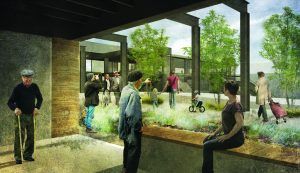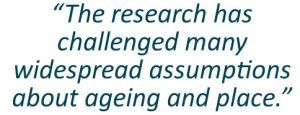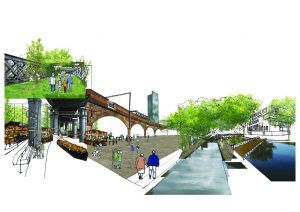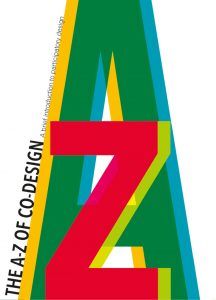A recent SURF magazine contribution examined the value of engaging young people in planning and urban design processes. This article focuses on people at the other end of the age spectrum. Prof Catharine Ward Thompson tells us about her important emerging research into collaborative place design, and what actions can be taken to improve the quality of life for people aged 60+.

Sheltered social spaces underneath age-friendly housing enable older people to ‘rest, retreat and regard’ in this proposal by Roseanne Knight, Jonathon Phillips, Stephanie Sharpe and local older people
When it comes to getting outdoors, the mundane matters and the commonplace counts. This is a useful reminder that the things many of us take for granted about our streets, parks and neighbourhoods can easily be overlooked in our enthusiasm for new plans and exciting design visions.
While good place-making is often innovative, it can’t create places that are open to all if we don’t take into account a wide range of abilities, perspectives and experiences.
If Community Empowerment is about making the most of diversity, then we need an approach to place-making that captures the meaningful involvement of as many end users as possible, right from the start. In our research project, Mobility, Mood and Place (MMP), we’ve been exploring how to do just that, with a particular focus on people in older age, drawing on insights from a range of fields: from planning to design, geography to health, and sociology to gerontology.
Funded by the UK Research Councils’ Lifelong Health and Wellbeing programme, MMP has looked at how places can be designed collaboratively to support outdoor activity, health, wellbeing and community engagement as people age. From measuring brainwaves outdoors, to looking at archival data on how environments have changed over time, the project has involved a wide and novel range of methods.
Co-design is the method which has perhaps given us the most insight into older people’s needs and preferences for age-friendly environments, challenging many widespread assumptions about ageing and place along the way. Led by experts in architecture and landscape architecture, 84 students have participated in the co-design element of MMP, largely from postgraduate programmes at Edinburgh College of Art, along with 72 older people in three locations across the UK.
is the method which has perhaps given us the most insight into older people’s needs and preferences for age-friendly environments, challenging many widespread assumptions about ageing and place along the way. Led by experts in architecture and landscape architecture, 84 students have participated in the co-design element of MMP, largely from postgraduate programmes at Edinburgh College of Art, along with 72 older people in three locations across the UK.
What Co-design Is
With its roots in Scandinavian workplace democracy projects of the 1970s, co-design is based on the idea of the designer ceding control to users and other stakeholders, ‘facilitating’ rather than ‘directing’ the design process. Otherwise known as participatory design, co-production or co-creation, it’s an approach to the design process, rather than a specific technique, and in fact there are many methods and techniques you can use.

Hypothesis drawing for an elevated linear park in Manchester from co-design work by Roseanne Knight, Jonathon Phillips, Stephanie Sharpe and local older people.
In place-making, some of the most inclusive co-design techniques include simple drawing and model-making, walk-and-talk site visits, photo diaries, and community mapping. From the northern Scottish islands of Orkney to Hackney Wick in London, we’ve used all of these techniques in Mobility, Mood and Place, generating sophisticated final designs from group exercises involving scale models and basic materials such as foam and plasticine.
In co-design, consensus isn’t always possible, or perhaps even desirable. But the act of getting together to talk about – and walk about – space does tend to create a less adversarial decision-making environment and, ultimately, greater support for final designs. Managed well, and with good humour, disagreement can actually be a healthy generator of new, more robust ideas and is excellent for challenging assumptions.
In MMP we found many ideas that, as designers, ran counter to what we expected of our older participants, particularly in their attitudes to the forgotten and abandoned infrastructure of inner city areas. ‘Starting from scratch’ wasn’t their default position; instead, many people wanted to see these places invested in and given new life which, in our work, became an important thematic driver.

Quality of Life Impacts
Among the participants in our co-design work, ‘access to others’ emerged as one of four key place factors which really make a difference to quality of life; the others being ‘access to nature’, ‘access for all’, and ‘access to light’.
Instead of segregated communities, there was strong support for public spaces and buildings that offered opportunities for intergenerational interaction, enabling older people to engage with public activity, but also to rest, retreat and regard or view activities without necessarily having to participate.

The A-Z of Co-design introductory report is available for free from the MMP website
Green spaces seem to be restorative, offering a respite from the tiring demands that busy urban places make on our directed attention. In one of our groups’ co-designed proposals for Manchester, a disused viaduct was transformed into an elevated linear park with housing, a theatre and a new station ‘plugging in’ to the green route at different points. The linear park offered a way to engage with different parts of city while avoiding busy roads and difficult crossings.
Looking at mobility in particular, we found that even a short walk can lift the mood if the environment is sufficiently varied. Things like colour and wildlife, opportunities for social contact, and familiar places, especially those linked to key memories, are highly valued, while everyday things, such as pavement quality, benches and street lighting, can make all the difference to confidence in going out and about as we get older.
As part of the Mobility, Mood and Place project, a bite-sized guide to co-design, The A-Z of Co-Design: A brief introduction to participatory design, has been produced. Co-designed proposals from the research, with notes on age-friendly design and quotes from participants, are showcased in the publication: Mobility. Mood. Place. Intergenerational co-design for age-friendly places. Both publications can be downloaded, for free, from: www.mobilitymoodplace.ac.uk
